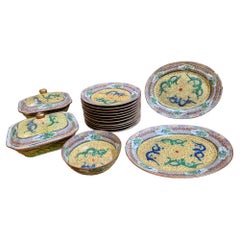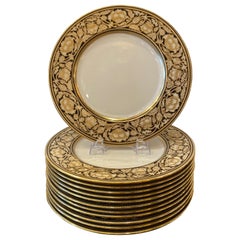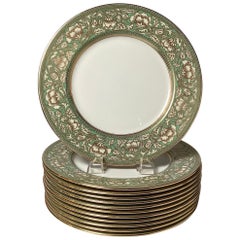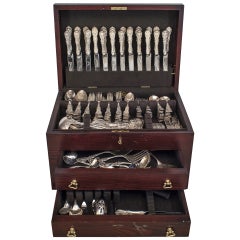1920s Dinner Service
Vintage 1920s Chinese Dinner Plates
Ceramic, Glass
Vintage 1920s American Dinner Plates
Porcelain
Early 20th Century American Dinner Plates
Porcelain
Early 20th Century French Baroque Sterling Silver
Sterling Silver, Brass
People Also Browsed
Antique Early 19th Century European Country More Dining and Entertaining
Pottery
20th Century Tableware
Sterling Silver
Vintage 1960s Danish Scandinavian Modern Shelves and Wall Cabinets
Teak
21st Century and Contemporary Italian Mid-Century Modern Flush Mount
Metal
21st Century and Contemporary Italian Pillows and Throws
Velvet
Mid-20th Century Uzbek Suzani Central Asian Rugs
Cotton
21st Century and Contemporary French Post-Modern Chandeliers and Pendants
Metal
1990s Italian Renaissance Sterling Silver
Sterling Silver
Antique 1870s English Georgian Fireplaces and Mantels
Pine
Early 20th Century Chinese Sculptures and Carvings
Coral
2010s Indian Organic Modern Animal Sculptures
Nickel
20th Century Belgian Art Deco Vases
Pottery
Vintage 1950s French Mid-Century Modern Ashtrays
Brass
Early 20th Century German Regency Serving Pieces
Porcelain
20th Century Tableware
Silver
Mid-20th Century American Hollywood Regency Loveseats
Faux Leather
1920s Dinner Service For Sale on 1stDibs
How Much is a 1920s Dinner Service?
Finding the Right Serveware, Ceramics, Silver And Glass for You
Your dining room table is a place where stories are shared and personalities shine — why not treat yourself and your guests to the finest antique and vintage glass, silver, ceramics and serveware for your meals?
Just like the people who sit around your table, your serveware has its own stories and will help you create new memories with your friends and loved ones. From ceramic pottery to glass vases, set your table with serving pieces that add even more personality, color and texture to your dining experience.
Invite serveware from around the world to join your table settings. For special occasions, dress up your plates with a striking Imari charger from 19th-century Japan or incorporate Richard Ginori’s Italian porcelain plates into your dining experience. Celebrate the English ritual of afternoon tea with a Japanese tea set and an antique Victorian kettle. No matter how big or small your dining area is, there is room for the stories of many cultures and varied histories, and there are plenty of ways to add pizzazz to your meals.
Add different textures and colors to your table with dinner plates and pitchers of ceramic and silver or a porcelain lidded tureen, a serving dish with side handles that is often used for soups. Although porcelain and ceramic are both made in a kiln, porcelain is made with more refined clay and is more durable than ceramic because it is denser. The latter is ideal for statement pieces — your tall mid-century modern ceramic vase is a guaranteed conversation starter. And while your earthenware or stoneware is maybe better suited to everyday lunches as opposed to the fine bone china you’ve reserved for a holiday meal, handcrafted studio pottery coffee mugs can still be a rich expression of your personal style.
“My motto is ‘Have fun with it,’” says author and celebrated hostess Stephanie Booth Shafran. “It’s yin and yang, high and low, Crate & Barrel with Christofle silver. I like to mix it up — sometimes in the dining room, sometimes on the kitchen banquette, sometimes in the loggia. It transports your guests and makes them feel more comfortable and relaxed.”
Introduce elegance at supper with silver, such as a platter from celebrated Massachusetts silversmith manufacturer Reed and Barton or a regal copper-finish flatware set designed by International Silver Company, another New England company that was incorporated in Meriden, Connecticut, in 1898. By then, Meriden had already earned the nickname “Silver City” for its position as a major hub of silver manufacturing.
At the bar, try a vintage wine cooler to keep bottles cool before serving or an Art Deco decanter and whiskey set for after-dinner drinks — there are many possibilities and no wrong answers for tableware, barware and serveware. Explore an expansive collection of antique and vintage glass, ceramics, silver and serveware today on 1stDibs.
- What is a dinner service?1 Answer1stDibs ExpertOctober 12, 2021Dinner service is a collection of coordinating tableware used to serve a meal. The 20-piece dinner service sets, which serve around four people, are the most popular. Each set normally includes a plate, salad bowl, teacup, and saucer. On 1stDibs, find a variety of antique dinner service sets.
- 1stDibs ExpertMarch 22, 2022In the 1920s, flappers often wore straight, fitted dresses with plunging necklines and knee-length hems. Fringe was a common embellishment used at the time. Flappers also sported pumps and opted for bras and lingerie instead of corsets for undergarments. Shop a variety of vintage clothing on 1stDibs.
- What do I wear to a 1920s party?1 Answer1stDibs ExpertMarch 3, 2023To a 1920s party, you can wear a short fringed or beaded flapper dress, layers of long beaded or pearl necklaces, elbow-length gloves and a feathered headband. Another option is to wear an off-white men's suit. Shop a selection of vintage apparel on 1stDibs.
- What is 1920s furniture called?1 Answer1stDibs ExpertNovember 13, 2024What 1920s furniture is called depends on its style. However, the most prominent design style of the decade was Art Deco. The term alone conjures visions of the Roaring Twenties, Machine Age metropolises, vast ocean liners, sleek typography and Prohibition-era hedonism. The iconic movement made an indelible mark on all fields of design throughout the 1920s and ’30s, celebrating society’s growing industrialization with refined elegance and stunning craftsmanship. Art Deco furniture often featured bold geometric lines, floral forms, shimmering mirrored finishes, sleek metal accents, and the use of expensive materials such as shagreen or marble as well as exotic woods such as mahogany, ebony and zebra wood. On 1stDibs, find a diverse assortment of Art Deco furniture.
- 1stDibs ExpertJune 15, 2023In the 1920s, fashionable colors included jewel tones. Fashion, jewelry, furniture and decorative objects often featured jade green, deep reds, amethyst purple, dusty mustard yellow and peacock blue. Find a range of 1920s-era jewelry and fashion on 1stDibs.
- 1stDibs ExpertMay 5, 2023In the 1920s, brides often wore tubular-shaped slip dresses with a beaded tunic over top. Hemlines usually fell just below the knee or to the ankle, and many gowns had dropped waists. For headwear, brides often showed off veils attached to cloche or flapper-style headbands. On 1stDibs, shop a collection of wedding dresses from some of the world’s top boutiques.
- 1stDibs ExpertApril 5, 2024The clothing style in the 1920s that most people think of first is the flapper style. Women who dressed in this style sported loose-fitting, short dresses, often outfitted with drop waists and fringe. Small cloche hats and headbands were signature accessories of the flapper look. During the decade, pleated tennis skirts and cardigan sweater sets left the courts and became staples of some women's everyday styles. For men, soft collars replaced stiff, starched ones, and simple single and double-button suit jackets worn without waistcoats became trendy. Trousers also took on a new shape with wider-cut legs, and Oxford bags gained popularity. On 1stDibs, shop a variety of 1920s apparel and accessories.
- What are 1920s dresses called?1 Answer1stDibs ExpertFebruary 13, 2023The iconic dresses from the 1920s are called flapper dresses. This name comes from the term flapper, which was used to describe young women during the period who enjoyed personal fulfillment and independence in American cities, particularly as they gained the right to vote and enjoy other freedoms previously reserved for men. Flappers danced at jazz clubs and upended most societal restrictions placed on women at the time, and fashion statements typically attributed to flappers included short “bob” haircuts, higher hemlines and other then-audacious style choices. Find a selection of flapper dresses on 1stDibs.
- What era is 1920s jewelry?1 Answer1stDibs ExpertDecember 4, 2023What era 1920s jewelry is depends on its design. Most people associate this decade with the Art Deco movement, which took inspiration from eclectic sources like Cubism, ancient Egypt and Native American, African and Asian motifs. However, some pieces produced during the 1920s are more in line with the style trends of earlier periods, such as Art Nouveau, Edwardian and Victorian. Explore a diverse assortment of 1920s jewelry on 1stDibs.
- 1stDibs ExpertApril 5, 2022Flapper dresses from the 1920s came in a range of colors, although darker hues such as black and navy were immensely popular. Flapper dresses were cut with straight and slim silhouettes, were typically knee-length and had a lower neckline. They were often made from silk chiffon and featured beaded details. You’ll find a selection of 1920s flapper dresses from some of the world’s top sellers on 1stDibs.
- 1stDibs ExpertMay 5, 2023The type of tile that was used in the 1920s was primarily ceramic. Many shapes were available, including basketweave, penny round, pinwheel, square and subway. Hexagon tiles, however, which are still on trend, have been in use in bathrooms since at least the early 1900s. The choice of hexagonal tiles is believed to have been tied to cleanliness, as the small pieces could stand up to aggressive cleaning and could be easily replaced if needed. On 1stDibs, shop a collection of tiles from some of the world's top sellers.
- 1stDibs ExpertNovember 21, 2023In the 1920s, engagement rings still looked like rings but were representative of a diverse range of styles and influences. Art Deco diamond ring designs took inspiration from the contemporary Cubist movement as well as from ancient Egypt – a revival sparked by the opening of King Tut’s tomb in 1922. Native American, African and Asian motifs also inspired jewelry pieces. Diamonds in square and rectangular shapes incorporating angular steps – like emerald cuts, Asscher cuts and baguettes – were set against black onyx, rubies, sapphires and emeralds to create color-blocking effects. Platinum, 18-karat gold, 14-karat white gold and sterling silver were some of the favored metals of the decade. Find a wide range of Art Deco engagement rings on 1stDibs.
- 1stDibs ExpertJanuary 10, 2025Coco Chanel was considered one of the leading fashion designers in the 1920s and ’30s in Paris. The first Chanel shop was established in 1910 on rue Cambon by the young milliner Gabrielle Chanel, who had picked up the nickname “Coco” while working as a club singer. The boutique drew the attention of the Parisian fashion elite, who popularized her wide-brimmed Chanel Modes hats. Soon, she added a sportswear store in the Normandy resort town of Deauville, where Coco set the tone for her defining sense of style — traditionally masculine garments reimagined for feminine shapes, made from simple jersey fabric. Effortless and elegant, Chanel's designs promoted comfort and grace in women’s wear that had been dominated in the previous century by complicated layers of fabric and cumbersome corsets. She followed this success with a couture house, opened in 1915 in Biarritz. In 1926, Chanel introduced her first little black dress, reclaiming a color that had once been reserved for mourning and working-class women. That same decade, she debuted her perfume, Chanel No. 5, as well as the Chanel suit with a fitted skirt, inspired by the boxy lines of men’s clothing and employing a sporty tweed. During the 1920s, she also unveiled the predecessor for the 2.55 Flap bag, which remains one of Chanel's most popular offerings. Shop a large selection of Chanel apparel, bags and accessories on 1stDibs.
Read More
37 Cheerful Home Bars, Where Everybody (Literally) Knows Your Name
Simple or sophisticated, equipped with console, cart or custom cabinetry, these stylish bar areas deserve a toast.
How a Craving for Color Revolutionized Glass
After synthetic dyes changed fashion, home goods and printed matter, it was only a matter of time till glass caught up.
1882 Ltd. Looks to the Future of Ceramics in the U.K. with an Eclectic Exhibition and Auction
Faye Toogood and John Pawson are among the list of plate designers.
20 Inviting Dining Rooms Perfectly Arranged for Entertaining
Top interior designers show — and tell — us how to create delectable spaces for hosting dinner parties.
Paul Revere Crafted This Silver Coffee Pot 250 Years Ago
Perhaps best known as a Revolutionary War hero, Revere was also an accomplished silversmith, and this pot is now available on 1stDibs.
From Arne Jacobsen to Zaha Hadid, Top Designers Tackle Tableware
Clever objects like these make feasting even more festive.
How the Chunky, Funky Ceramics of 5 Mid-Century American Artists Balanced Out Slick Modernism
Get to know the innovators behind the pottery countercultural revolution.
Ready for a Cinderella Moment? This Glass Handbag Is a Perfect Fit
Glass slippers might be the stuff of fairytales, but glass handbags? Artist Joshua Raiffe has made them a reality, and they're far less delicate than you might imagine, but just as dreamy.



